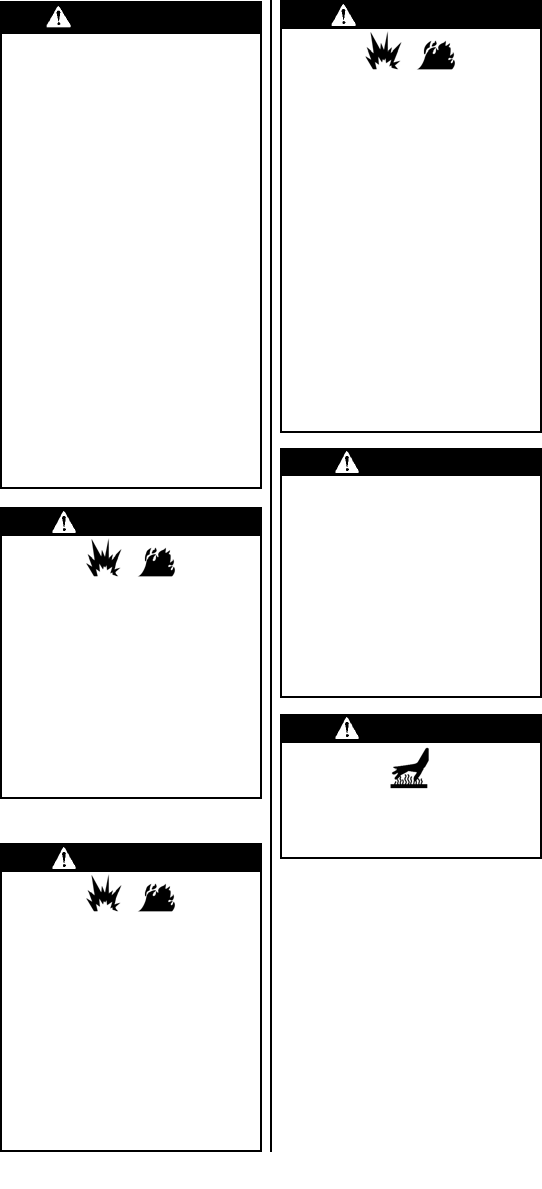
English-2
WARNING
DANGER
• EXPLOSION - FIRE HAZARD
• During lighting and operation, this product can
be a source of ignition. Never use the stove in
spaces that contain or may contain volatile or
airborne combustibles, or products such as
gasoline, solvents, paint thinner, dust particles
or unknown chemicals.Minimum clearances
from combustible materials: 24 inches from the
sides and 48 inches from the top.
• Provide adequate clearances around air
openings into the combustion chamber.
• Never attempt to operate stove if any plastic
tubing on the pump is missing or damaged.
WARNING
Not for home or recreational vehicle use.
We cannot foresee every use which may be
made of our products.
Check with your local fire safety authority if
you have questions about use.
Other standards govern the use of fuel gases
and heat producing products for specific uses.
Your local authorities can advise you
about these.
• Never refill disposable LPG canisters.
• Use only Coleman
®
accessories or parts.
During stove set-up, check all fittings for
leaks using soapy water. Never use a flame.
WARNING
• BURN HAZARD
• Never leave stove unattended when hot
or in use.
• Keep out of reach of children.
This multi-fuel appliance may be fueled by LPG,
or Coleman® Liquid Fuel, or unleaded gasoline.
Warnings specific to LPG fuel:
• LPG is invisible, odorless, and flammable.An
odorant is normally added to help detect leaks
and can be described as a ”rotten egg” smell.
The odorant can fade over time so leaking gas
is not always detectable by smell alone.
• LPG is heavier than air and leaking LPG will
sink to the lowest level possible. It can ignite by
ignition sources including matches, lighters,
sparks or open flames of any kind many feet
away from the original leak.
• Use only LPG set up for liquid withdrawal.
• LPG should be stored or used in compliance with
local ordinances and codes or with ANSI/NFPA
58 and CAN/CGA B-149.2.Turn off LPG when
not in use.
Warnings specific to Liquid fuel:
• Never use leaded automotive fuel.
• Do not use Canadian unleaded gasoline.
• Store fuel in a clean, properly marked
container away from flame (including pilot
lights), other sources of ignition, or
excessive heat.
DANGER
• EXPLOSION - FIRE HAZARD
Dangers specific to Liquid fuel:
• Coleman® fuel and gasoline are extremely
flammable; handle with care. Fuel vapors are
invisible, explosive, and can be ignited by
ignition sources may feet away.
• Always fill outdoors.
• Never open a pressurized Coleman® fuel
bottle or fill fuel bottle near flame (including
pilot lights), or other ignition sources. It is
normal for a pressurized fuel bottle to vent a
small amount of fuel mist when unscrewing
the bottle from the black pump. Be sure stove
has no flame before opening fuel canister.
• Coleman® stove Models 9770/9775 are
designed for use only with fuel bottles marked
“Models 9770/9775”. Never attempt to attach
any other fuel bottle to these stoves. Never
attempt to attach this fuel bottle to any other
appliance. Fuel leakage and pump damage
can result.
DANGER
• EXPLOSION - FIRE HAZARD
Dangers specific to LPG fuel:
• Never store LPG (liquefied petroleum gas)
near high heat, open flames, pilot lights, direct
sunlight, other ignition sources or where
temperatures exceed 120 degrees F (49°C).
• LPG is heavier than air and can accumulate in
low places.If you smell gas, leave the area
immediately.
• Never install or remove LPG canister while
outdoor stove is lighted, near flame, pilot lights,
other ignition sources or while outdoor stove is
hot to touch.


















